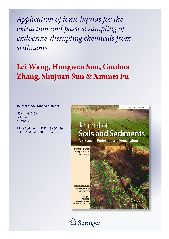摘要
The aim of this study was to assess the applicability of ionic liquids (ILs) in the extraction of organic contaminants from sediments and in passive sampling as a receiving phase material. Solutions of two water-soluble ionic liquids (WSILs)-1-butyl-3-methyl imidazolium tetrafluoroborate ([BMIm]BF4) and N-butyl-3-methyl pyridinium tetrafluoroborate ([BMPy]BF4)-were used for the extraction of endocrine-disrupting chemicals (EDCs), including bisphenol A (BPA), 17 beta-estradiol (E2), and nonylphenol (NP), from different sediments. Furthermore, a hydrophobic IL (1-hexadecyl-3-methyl imidazolium hexafluorophosphate) was filled in a polyethylene (PE) membrane tubing to build an IL-PE passive sampler for sediment pore water. Uptake kinetics were studied by exposing samplers to sediments artificially contaminated by EDCs and identified by exposing samplers to field-contaminated sediments. EDCs were efficiently extracted by WSIL solutions from the two artificially contaminated sediments, with maximum extraction efficiencies of 84.2-104.6 % by the [BMIm]BF4 solution and 74.9-103.7 % by the [BMPy]BF4 solution. However, WSIL solutions are not suitable for EDC extraction from sediment with very low organic carbon contents. EDCs in sediment pore water can be efficiently taken up by the IL-PE sampler, with uptake rate constants of 2.08 x 10(-2) l g(-1) day(-1) (BPA), 5.74 x 10(-2) l g(-1) day(-1) (E2), and 2.10 l g(-1) day(-1)(NP). BPA, E2, and NP can be extracted efficiently by IL water solution from most of the artificially and field-contaminated sediments used in this study. The IL ([HDMIm]PF6)-PE passive sampler can be used to monitor EDCs in the pore water of sediments. A good match between the calculated and measured concentrations of BPA and E2 in pore water of field-contaminated sediments was observed.
